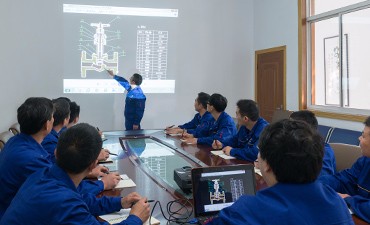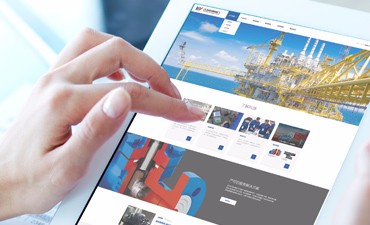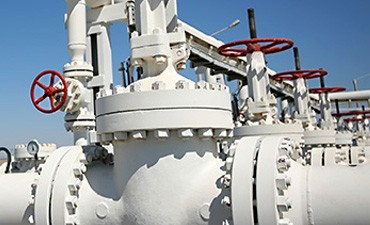The working principle, installation and maintenance of pneumatic control valve
Release time:2018-09-15Browsing volume:910
Working principle
Pneumatic control valve is to use compressed air as the power source, cylinder as the actuator, and with the aid of electrical valve positioner, converter, solenoid valve, retaining valve and other accessories to drive the valve, to achieve switching or proportional regulation, receiving industrial automation control system control signals to complete the regulation of pipeline media: flow, retention valve and other accessories to regulate the valve. Various technological parameters such as pressure and temperature. Pneumatic control valve is characterized by simple control, rapid response, and inherent safety, no need to take additional explosion-proof measures.
Pneumatic control valve is usually composed of pneumatic actuator and control valve connection installation and debugging, pneumatic actuator can be divided into single-acting and double-acting two kinds, single-acting actuator with reset spring, and double-acting actuator without reset spring. The single-acting actuator can be automatically relocated to the opening or closing state set initially by the valve in case of loss of origin or sudden failure.
The pneumatic control valve is divided into two types according to the action form, namely normal open and normal closed. The pneumatic control valve is usually opened or closed by the positive and negative action of the actuator and different assembling methods of the valve structure.
Action mode of pneumatic control valve
Air-open (normally closed) is when the pressure above the diaphragm head increases, the valve moves in the direction of increasing the opening, when the upper limit of the input pressure is reached, the valve is fully open. Conversely, when the air pressure decreases, the valve moves in the direction of closing, and when there is no air input, the valve is completely closed. Normally, we call the gas operated control valve as the fault closed valve.
The gas direction (normally open) action direction is exactly opposite to the gas opening type. When the air pressure increases, the valve moves toward the closed direction; when the air pressure decreases or is not there, the valve opens toward the open direction or until it is fully opened. Generally speaking, we call the gas control valve a malfunction open valve.
The choice of gas opening and closing is based on the safety angle of technological production. When the gas source is cut off, whether the regulating valve is in the closed position is safe or open.
For example, a furnace's combustion control, a regulator installed in a fuel pipe, controls the supply of fuel according to the temperature of the furnace or the temperature of the heated material at the furnace outlet. At this time, it is better to choose the air valve is safer, because once the supply of air stops, the valve in the closed valve than the valve in full open more appropriate. If the gas source is interrupted, the full opening of the fuel valve will result in excessive heat. Another example is a cooling water cooling heat exchanger equipment, heat materials in the heat exchanger and cooling water heat exchange is cooled, regulating valve installed in the cooling water pipe, with the heat exchanged material temperature to control the cooling water volume, in the gas source interruption, the regulating valve should be in the open position more safely, the appropriate choice of AIR-OFF type (FO) regulation. Valve.
Valve positioner
The valve positioner is the main accessory of the control valve. It is used with the pneumatic control valve. It receives the output signal of the regulator, and then controls the pneumatic control valve with its output signal. When the control valve moves, the displacement of the valve stem is fed back to the valve positioner through the mechanical device, and the valve position is transmitted to the upper by the electric signal. Bit system. Valve positioner can be divided into pneumatic valve positioner, electro-pneumatic valve positioner and intelligent valve positioner according to its structure and working principle.
The valve positioner can increase the output power of the regulating valve, reduce the transmission lag of the regulating signal, speed up the moving speed of the valve stem, improve the linearity of the valve, overcome the friction of the valve stem and eliminate the influence of unbalanced force, so as to ensure the correct positioning of the regulating valve.
The actuator is divided into pneumatic actuators and electric actuators, with straight travel and angular stroke. To automatically and manually open and close various kinds of door and wind panels.
Air-open (normally closed) is when the pressure above the diaphragm head increases, the valve moves in the direction of increasing the opening, when the upper limit of the input pressure is reached, the valve is fully open. Conversely, when the air pressure decreases, the valve moves in the direction of closing, and when there is no air input, the valve is completely closed. Normally, we call the gas operated control valve as the fault closed valve.
The gas direction (normally open) action direction is exactly opposite to the gas opening type. When the air pressure increases, the valve moves toward the closed direction; when the air pressure decreases or is not there, the valve opens toward the open direction or until it is fully opened. Generally speaking, we call the gas control valve a malfunction open valve.
The choice of gas opening and closing is based on the safety angle of technological production. When the gas source is cut off, whether the regulating valve is in the closed position is safe or open.
For example, a furnace's combustion control, a regulator installed in a fuel pipe, controls the supply of fuel according to the temperature of the furnace or the temperature of the heated material at the furnace outlet. At this time, it is better to choose the air valve is safer, because once the supply of air stops, the valve in the closed valve than the valve in full open more appropriate. If the gas source is interrupted, the full opening of the fuel valve will result in excessive heat. Another example is a cooling water cooling heat exchanger equipment, heat materials in the heat exchanger and cooling water heat exchange is cooled, regulating valve installed in the cooling water pipe, with the heat exchanged material temperature to control the cooling water volume, in the gas source interruption, the regulating valve should be in the open position more safely, the appropriate choice of AIR-OFF type (FO) regulation. Valve.
Valve positioner
The valve positioner is the main accessory of the control valve. It is used with the pneumatic control valve. It receives the output signal of the regulator, and then controls the pneumatic control valve with its output signal. When the control valve moves, the displacement of the valve stem is fed back to the valve positioner through the mechanical device, and the valve position is transmitted to the upper by the electric signal. Bit system. Valve positioner can be divided into pneumatic valve positioner, electro-pneumatic valve positioner and intelligent valve positioner according to its structure and working principle.
The valve positioner can increase the output power of the regulating valve, reduce the transmission lag of the regulating signal, speed up the moving speed of the valve stem, improve the linearity of the valve, overcome the friction of the valve stem and eliminate the influence of unbalanced force, so as to ensure the correct positioning of the regulating valve.
The actuator is divided into pneumatic actuators and electric actuators, with straight travel and angular stroke. To automatically and manually open and close various kinds of door and wind panels.
Air-open (normally closed) is when the pressure above the diaphragm head increases, the valve moves in the direction of increasing the opening, when the upper limit of the input pressure is reached, the valve is fully open. Conversely, when the air pressure decreases, the valve moves in the direction of closing, and when there is no air input, the valve is completely closed. Normally, we call the gas operated control valve as the fault closed valve.
The gas direction (normally open) action direction is exactly opposite to the gas opening type. When the air pressure increases, the valve moves toward the closed direction; when the air pressure decreases or is not there, the valve opens toward the open direction or until it is fully opened. Generally speaking, we call the gas control valve a malfunction open valve.
The choice of gas opening and closing is based on the safety angle of technological production. When the gas source is cut off, whether the regulating valve is in the closed position is safe or open.
For example, a furnace's combustion control, a regulator installed in a fuel pipe, controls the supply of fuel according to the temperature of the furnace or the temperature of the heated material at the furnace outlet. At this time, it is better to choose the air valve is safer, because once the supply of air stops, the valve in the closed valve than the valve in full open more appropriate. If the gas source is interrupted, the full opening of the fuel valve will result in excessive heat. Another example is a cooling water cooling heat exchanger equipment, heat materials in the heat exchanger and cooling water heat exchange is cooled, regulating valve installed in the cooling water pipe, with the heat exchanged material temperature to control the cooling water volume, in the gas source interruption, the regulating valve should be in the open position more safely, the appropriate choice of AIR-OFF type (FO) regulation. Valve.
Valve positioner
The valve positioner is the main accessory of the control valve. It is used with the pneumatic control valve. It receives the output signal of the regulator, and then controls the pneumatic control valve with its output signal. When the control valve moves, the displacement of the valve stem is fed back to the valve positioner through the mechanical device, and the valve position is transmitted to the upper by the electric signal. Bit system. Valve positioner can be divided into pneumatic valve positioner, electro-pneumatic valve positioner and intelligent valve positioner according to its structure and working principle.
The valve positioner can increase the output power of the regulating valve, reduce the transmission lag of the regulating signal, speed up the moving speed of the valve stem, improve the linearity of the valve, overcome the friction of the valve stem and eliminate the influence of unbalanced force, so as to ensure the correct positioning of the regulating valve.
The actuator is divided into pneumatic actuators and electric actuators, with straight travel and angular stroke. To automatically and manually open and close various kinds of door and wind panels.
Air-open (normally closed) is when the pressure above the diaphragm head increases, the valve moves in the direction of increasing the opening, when the upper limit of the input pressure is reached, the valve is fully open. Conversely, when the air pressure decreases, the valve moves in the direction of closing, and when there is no air input, the valve is completely closed. Normally, we call the gas operated control valve as the fault closed valve.
The gas direction (normally open) action direction is exactly opposite to the gas opening type. When the air pressure increases, the valve moves toward the closed direction; when the air pressure decreases or is not there, the valve opens toward the open direction or until it is fully opened. Generally speaking, we call the gas control valve a malfunction open valve.
The choice of gas opening and closing is based on the safety angle of technological production. When the gas source is cut off, whether the regulating valve is in the closed position is safe or open.
For example, a furnace's combustion control, a regulator installed in a fuel pipe, controls the supply of fuel according to the temperature of the furnace or the temperature of the heated material at the furnace outlet. At this time, it is better to choose the air valve is safer, because once the supply of air stops, the valve in the closed valve than the valve in full open more appropriate. If the gas source is interrupted, the full opening of the fuel valve will result in excessive heat. Another example is a cooling water cooling heat exchanger equipment, heat materials in the heat exchanger and cooling water heat exchange is cooled, regulating valve installed in the cooling water pipe, with the heat exchanged material temperature to control the cooling water volume, in the gas source interruption, the regulating valve should be in the open position more safely, the appropriate choice of AIR-OFF type (FO) regulation. Valve.
Valve positioner
The valve positioner is the main accessory of the control valve. It is used with the pneumatic control valve. It receives the output signal of the regulator, and then controls the pneumatic control valve with its output signal. When the control valve moves, the displacement of the valve stem is fed back to the valve positioner through the mechanical device, and the valve position is transmitted to the upper by the electric signal. Bit system. Valve positioner can be divided into pneumatic valve positioner, electro-pneumatic valve positioner and intelligent valve positioner according to its structure and working principle.
The valve positioner can increase the output power of the regulating valve, reduce the transmission lag of the regulating signal, speed up the moving speed of the valve stem, improve the linearity of the valve, overcome the friction of the valve stem and eliminate the influence of unbalanced force, so as to ensure the correct positioning of the regulating valve.
The actuator is divided into pneumatic actuators and electric actuators, with straight travel and angular stroke. To automatically and manually open and close various kinds of door and wind panels.
Valve positioner failure
The common locator works on the principle of mechanical force balance, that is, the nozzle baffle technology. There are mainly the following types of faults:
(1) Because of the mechanical force balance principle, there are many movable parts, which are susceptible to the influence of temperature and vibration, resulting in the fluctuation of the control valve.
(2) Using nozzle baffle technology, because the nozzle hole is very small, easy to be blocked by dust or unclean gas source, so that the positioner can not work properly;
(3) Adopting the principle of force balance, the spring's elastic coefficient will change in the harsh field, resulting in the non-linearity of the control valve and the quality of control will decline.
(4) Intelligent positioner is composed of microprocessor (CPU), A/D, D/A converter and other components. Its working principle is completely different from that of ordinary positioner. The comparison between the given value and the actual value is purely electric signal, not force balance. Therefore, it can overcome the shortcomings of the conventional positioner's force balance. But when used in emergency parking lots, such as emergency shutoff valves, emergency relief valves, these valves are required to be stationary in a certain position, only when an emergency occurs, it is necessary to act reliably, stay in a certain position for a long time, easy to cause electrical converter out of control and small signal does not operate dangerous situation. In addition. The position sensor potentiometer used for valve is in danger of small signal inactivation and large signal full opening because of its working in the field. Therefore, in order to ensure the reliability and availability of intelligent positioners, they must be tested frequently.
With the development of technology and the improvement of product safety performance, electric actuators have gradually appeared in the field of chemical industry.
(source:http://prcvalve.com/News/7)

Return
Disclaimer:This website is reproduced by editors of our website. The purpose of reproducing is to convey more information. It does not mean that our website agrees with its views and is responsible for its authenticity. If it involves the content, copyright and other issues, please contact us within 30 days, we will delete the content at the first time! [Statement] The copyright of the article on this site belongs to the original author and provides reference only for the author's personal opinions. It does not constitute any investment and application suggestions. This station has the final right to interpret this statement.






